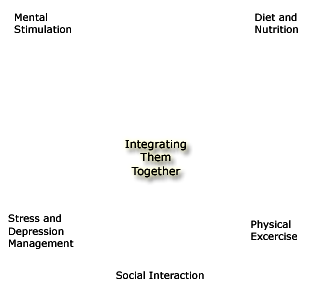Part II: Causes and Prevention of Strokes, Heart Attacks and Vascular Dementia
 Last month we reviewed a section of Dr. Perlmutter’s new book Grain Brian, talking about the essential role of Cholesterol for the brain and body. Many were surprised to learn that cholesterol, even LDL (a cholesterol carrying low density lipoprotein) rather than being bad is really essential for physical and mental health – unless oxidized or damaged by the forces noted below.
Last month we reviewed a section of Dr. Perlmutter’s new book Grain Brian, talking about the essential role of Cholesterol for the brain and body. Many were surprised to learn that cholesterol, even LDL (a cholesterol carrying low density lipoprotein) rather than being bad is really essential for physical and mental health – unless oxidized or damaged by the forces noted below.
However, the question some then asked was: “If cholesterol does not cause heart or vascular disease, then what does?” Although Dr Perlmutter’s focus in his book is on brain health rather than heart health, he does address that question as well. (Of course vascular disorders like high blood pressure, atherosclerosis, TIA’s, etc. have long been seen as primary contributors to a variety of brain disorders including Alzheimer’s.) But as much as I admire the man, I didn’t want to take Perlmutter’s word for this alone. Fortunately, and coincidentally, one of the top senior research organizations in the world – Life Extension Foundation – just wrote a series of articles on this very subject. In fact their latest, best article (with over 140 scientific references) just came out in their May Issue, which I just received an advanced of last week (that issue is not yet posted on line, but will be in May).
So in this Newsletter/blog (perhaps my most important yet) I will share with you what the latest research and other experts suggest are the greater villains in this drama. And what you and your loved ones can do to protect you heart, and vascular system from the other, more dangerous marauders plaguing your body and brain.
What Causes Cardio Vascular Disease (CVD)
It is interesting to note that the Life Extension Foundation takes a more traditional stance on cholesterol than Perlmutter, agreeing with the CDC that reducing LDL should reduce the risk for adverse vascular events (despite Perlmutter’s convincing evidence to the contrary). However, they believe the traditional medical approach taken in America “understates” the facts – that lost in the commercial hype about statins like Lipitor, Crestor, etc is the fact that there are “other preventable causes of vascular disease overlooked by hurried physicians.” Moreover, several of these, research is now showing (as Perlmutter notes) are likely much greater risk factors for strokes and heart attacks than are cholesterol and LDL – cholesterol carrying proteins.
Other Critical Risk Factors
Not the least of these risk factors is low HDL cholesterol. Some clinics only provide patients with a total cholesterol score. Not only is this meaningless, it’s confusing, as scientists long ago documented the ability of HDL (high-density lipoprotein – the “good” cholesterol carrier) to protect against LDL oxidation and accumulation, and remove cholesterol affixed to arterial walls and transport it to the liver for safe disposal.1, 2, 3, 4 (Keep in mind that the LDL protein itself in not bad, in fact it is vital to carry essential cholesterol to the brain to nourish our brain cells, and high cholesterol in the brain, as previously noted, is essential to mental/brain health, especially as we age.)
HDL does more than just cleanse arterial walls of plaque however. In protecting LDL against oxidation (damage from free radicals) it also reduces chronic inflammation, vascular adhesion molecules, and platelet activation-all factors that can lead to atherosclerosis.
This is why it is so important to maintain HDL levels above 50 mg/ dL of blood and follow steps outlined below to ensure optimal “reverse cholesterol transport” of lipids away from the arterial wall.
For HDL to perform its vital functions, an enzyme called paraox-onase-1 (PON-1) is attached to its surface.5, 6 Aging and poor diet result in a marked decline in PON-1 levels, thereby reducing the ability of HDL to protect against heart attack and stroke.7, 8 This phenomenon helps explain the onset of accelerated atherosclerosis; where within a period of only a few years, an aging person’s healthy arteries can occlude (narrow) with plaque.9
The age-related reduction in PON-1 may also explain studies showing statin drugs lose their benefit in certain aging populations, since the effects of statins are no longer sufficient to protect against the multiple factors involved in the development of atherosclerosis in the elderly.8, 9,10
Sweet & Slow Poison
Other than low HDL perhaps the other greatest risk factor for atherosclerosis or vascular disease is high sugar intake and a condition called insulin resistance (IR).18, 19 IR is characterized by high blood sugar levels and high insulin, both of which have been proven in high amounts to increase risk for atherosclerosis.19, 20 Insulin is required to transport glucose into the cells mitochondria for energy production. However, if our cells are exposed to too much glucose or refined carbohydrates i.e. sugar and flour (which is readily converted to sugar in the body) they will begin to block insulin from entering their cells. When sugar is not metabolized for energy it can end up damaging enzymes and other protein and lipid structures in a process called glycation. Excess insulin spikes in arteries can also cause serious damage.18-20
As Dr. Perlmutter notes: “Glycosylated proteins, which are the products of these reactions between proteins and sugar molecules, are associated with a fifty-fold increase in free radical formation.”21 These free radicals are like sparks from a bonfire, that can damage other proteins and cells they come in contact with, resulting in at least 3 adverse effects commonly suffered by individuals with vascular or Alzheimer’s disease.
1. These free radicals can alter proteins and create protein bits or peptides called oligomers, which then compete with insulin, blocking insulin receptor sites, thus preventing insulin and glucose from entering the cell and being converted into energy in the mitochondria. As a result these cells become weak and dysfunctional, rather they are in our arteries or brain.22
2. These free radicals can then oxidize and damage LDL, lipoproteins, rendering them less capable of delivering cholesterol to the brain, making it more likely that they will become stuck to arterial walls, thus creating the plaques that can lead to a stroke.21
3. Free radicals create damaged proteins called amyloid, which have long been tied to Alzheimer’s. The latest insights suggest these are like tooth picks that prick holes in brain cells, leading to their destruction.22, 23 When quarried on this topic one leading Alzheimer’s researcher recently wrote me that refined “sugar is like poison to the brain plain and simple.”26
So how much difference can this make for our vascular health? A recent study from JAMA (Journal of the American Medical Association) Internal Medicine 45 suggests that a high sugar diet could significantly increase the risk of dying from cardiovascular disease.
Researchers at the Center for Disease Control evaluated data from participants in the National Health and Nutrition Examination Surveys (NHANES) of the US population. While 71.4% of adults consumed al least 10% or more of their calories from added sugar during 2005-2010, sugar counted for at least 25% of the calories among 10% of the group. When the researchers examined the association between added sugar and the risk of cardiovascular death over 14.6 years of follow-up, subjects whose intake was among the top one-fifth of participants had an adjusted risk that was twice that of participants whose intake was among the lowest fifth. In other words, if you consume high amounts of sugars (or other simple carbs for that matter) especially from beverages, reducing those could cut your risk in half. That is far better than any statin has been shown to do! Moreover, an intake of sugar that accounted for 25% or more of one’s calories was associated with a 2.75 or nearly 3 times greater risk of death due to cardiovascular disease in comparison to those whose intake comprised less than 10% of their total calories.25
Sugar substitutes are no better. A study presented early in 2011 from the University of Miami Miller School of Medicine showed those who drink a diet soda a day die 61% sooner than those who do not, and the study showed those are primarily from cardiovascular complications (These usually contain aspartame or NutraSweet.)53
Bottom line, many good studies both in the US and abroad have now shown that when people eat too many sugars, sweets and simple or refined carbohydrates (flour, pasta, etc) and not enough good high fiber, nutrient dense vegetables, and fats (as from fish, olive oil, and nuts) it creates insulin resistance and other problems which we can lead to serious inflammation in the arteries as well as the brain, and more than double their risk for diabetes, strokes, neuropathy, metabolic syndrome and even Alzheimer’s.19-25
That’s why many of the top cardiologists as well as Alzheimer’s researchers, and others throughout the world are now warning against eating too many sweets, treats, bread and pastas (simple processed carbs) and not enough vegetables, nuts and beans.25, 21
Are Your Arteries Inflamed?
Another undisputable major contributor to atherosclerosis, strokes and heart attacks is inflammation, characterized by high homocysteine and/or C-reactive protein in the blood. Inflammation is part of our normal immune response, but it’s somewhat like renovating your kitchen. If it persists and becomes chronic it creates more of a mess, making it harder for our cells to function properly and eventually they die. In our arteries, chronic inflammation not only initiates injuries to the endothelium, but also accelerates the progression of existing atherosclerotic lesions caused by other toxins.
A new study published just last year (2013) dramatically documented this point. The investigators reported on a large group of older individuals who were followed for 17 years. Those with the highest levels of inflammatory blood markers were more than 3 times as likely to suffer sudden cardiac death as those with the lowest levels.27
Unfortunately there are numerous things that have been shown to contribute to vascular inflammation. Basically anything that might damage the walls (endothelium) of our arteries and blood vessels can initiate this inflammatory response, as our body flies into action to patch up the damage. As noted above, these caustic contributors include excess intake of the wrong kinds of sugars (and sugar substitutes like aspartame and high fructose corn syrup), and resulting insulin spikes, but also the wrongs kinds of fats (TRANS or fried fats), tobacco smoke, smog, excess animal protein, food additives, a sedentary lifestyle, deficiencies of the B-vitamins, genetic abnormalities, prolonged exposure to cortisol from stress, unabsorbed calcium, excess iron and fibrin.28 Also often overlooked is the continuous toxic exposure our arteries and kidney’s bear from cellular waste products that are released into our bloodstream for filtration and excretion primarily through the kidneys.29
In small amounts when we are young our amazing arteries can handle all of these toxins, but their effects are cumulative so as we age, these, along with the chronic inflammation they provoke, take their toll.
Two other key factors, as we age, that leaves us vulnerable to this toxic takeover are the loss of hormones and nitric oxide.
Low Testosterone
Low testosterone in men is associated with excess abdominal fat,30,31 insulin resistance or loss of insulin sensitivity,32,33 atherosclerosis,34,35 and increased incidence of cardiovascular disease.36
A review of data gathered between 1970 and 2013 provided further evidence that low testosterone in men may be linked to a higher risk of developing or dying from cardiovascular disease.37
Another 2013 study confirmed the increase of metabolic syndrome in men that are testosterone deficient.38 Metabolic syndrome is a cluster of cardiovascular risk factors that include insulin resistance, hypertension, elevated tri-glycerides/LDL and low HDL,39 This study found that men treated with testosterone showed across the board improvements as indicated by:38
• Reduced LDL.
• Reduced triglycerides.
• Reduced glucose.
• Reduced C-reactive protein.
• Reduced measures of liver damage.
• Reduced blood pressure.
• Reduced hemoglobin Alc
• Increased HDL (removes cholesterol buildup from arterial walls).
Fortunately there are various effective ways to increase testosterone in men as we age. (See below)
Nitric Oxide Decline in Arterial Walls
An early step in the initiation of atherosclerosis is reduced nitric oxide bioavailabilily and the resulting endothelial dysfunction.40 Research in the last decade has shown that aging results in further impairment in our ability to synthesize endothelial nitric oxide that results in markedly accelerates atherosclerosis.41-43
In case you are not familiar with this new superstar in the fight against CVD: Nitric oxide is a gas with the chemical formula N-O (one molecule of nitrogen bound to one molecule of oxygen). In 1992 the journal Science proclaimed it “The Molecule of the Year.” In 1998, three pharmacologists were jointly awarded the Nobel Prize in Physiology or Medicine for their discovery that nitric oxide is a major signaling molecule in the cardiovascular system, where it signals the smooth muscles surrounding our arteries to relax, thus allowing for greater flexibility, dilation and improved blood flow. But it plays other roles as well. A large and growing body of research points to nitric oxide’s broad impact on health.40-44
In the endothelium N-O works to:
- Manage blood vessel dilation and constriction
- Regulate blood clotting
- Manage electrolyte levels
- Regulate internal fluid levels
- Support the immune system
- Act as a gatekeeper for substances traveling between the bloodstream and the tissues
Nitric oxide and endothelial health are closely intertwined. N-O helps keep the endothelium healthy; a healthy endothelium helps produce nitric oxide. Maintaining the proper functioning of this cycle is important for those who want to maintain a healthy vascular system.
What helps? (Remedies)
Now that we have identified a few more of the key players in this saga, some of the answers will be quite obvious, others less so. But here is what the current research shows would be most helpful in the fight against cardio vascular disease.
1. Reduce sugar and simple carb consumption. This is what Dr. Perlmutter, Dr. Davis, Dr. Hyman, Dr. Fila and a host of other researchers recommend,21,25 and the above noted studies would suggest. Of course this is not talked about much in commercials because it’s free! There are no commercial interests to fund this message. But as noted above, the evidence continues to astound us on it’s profound adverse effects on our body and brain.
2. Adopt a primarily Mediterranean diet high in vegetables, fruit, olive oil, nuts, bean and cold water fish – like sardines or wild caught salmon. A major study out of Bern Switzerland noted more than a decade ago that consuming 10 or more servings of various vegetables and fruits per day was more predictive of not having a future stroke or heart attack than was the absence of body fat or high LDL cholesterol.46
Another study in 2011 confirmed that strict adherence to a Mediterranean diet decreased the likelihood of ischemic stroke irrespective of cholesterol levels, age, and gender.47
A even more recent article published in the Feb 2014 journal PLoS One reaffirmed the protective value of a Mediterranean diet, against the risk of cardiovascular disease in Midwestern firefighters.48 In this study lifestyle questionnaire responses of 780 male firefighters were scored on their adherence to a Mediterranean-style diet. Subjects whose adherence to the diet was greatest had a 35% lower risk of metabolic syndrome in comparison with men whose adherence was lowest. The group with the greatest adherence also had a 43% lower risk of weight gain over the previous five years, lower body fat percentage, greater high-density lipoprotein (HDL) cholesterol levels and lower low-density lipoprotein (LDL) cholesterol.
3. Eat pomegranates and drink their juice and or resveratrol from grape skins. As noted above PON-1 anchored to the surface of HDL is emerging as a formidable defense against atherosclerosis.11, 12 Pharmaceutical companies would pay dearly for a drug that elevates PON-1 levels in the body. Fortunately, scientists have discovered pomegranate and resveratrol elevate PON-1 naturally to unleash its full antioxidant and anti-inflammatory power.13-17
In studying the effects of pomegranate alone over a one-year period, studies using human serum revealed an 83% increase in PON-1 activity and a 90% decrease in oxidized LDL. These same patients showed reversal in clinical measurements of atherosclerosis such as carotid artery narrowing.17 Again no statin has been shown to be as powerful in aiding HDL in the reversal of carotid artery narrowing. For a link to pomegranate juice and extract option Click here.
Note: I have been able to arrange discounts for my readers on most of the nutrients mentioned here. Simply click on the links provided. Purchases made from these links also help to support this otherwise unfunded website and blog.
4. Boost Nitric Oxide production with beet root lozenges or juice. N-O is abundant in the body, but it is unstable and short-lived, and thus must be renewed continuously. For years L-arginine was suggested for this purpose. However, it is not well absorbed in seniors. Beet root was found to be significantly more effective for seniors, and in recent years a product called Neo40 or Co2, a lozenge, was developed which when mixed with saliva produces a dramatic boost in nitric oxide which goes to work to open arteries within minutes. A plethora of recent research now shows these lozenges can effectively increase blood flow, decrease blood pressure, soften hardened arteries, reduce plaque, stroke risk, and joint pain, improve digestion, brain function and elevate mood.43,44 The only problem is they are not cheap. These are a bit pricey. But if you email me at DavidRJL@aol.com I will tell you how you can obtain these for less.
5. Exercise on a regular basis. There is no question that physical activity plays a very important role in preventing CVD, and managing related risk factors, including elevated triglyceridelevels, lowHDL, hypertension, insulin resistance, and obesity.47,48 It is in fact one of the best ways to increase the good HDL cholesterol, reduce systemic inflammation and boost N-O levels in the body. It also improves digestion and nutrient absorption, reduces that caustic stress hormone cortisol and of course improves circulation. The recommendation is that every US adult should accumulate at least 30 minute or more of moderate-intensity physical activity on most, preferably all, days of the week. Not sleeping well can also increase arterial plaque, and exercise facilitates better sleep!
6. Eat fish and take a high quality fish oil or Omega-3 supplement. There are over 3,000 studies supporting the value of Omega-3’s or fish oil for the vascular system. And most Americans are dangerously low in these essential fatty acids. Fish oil is one of the few natural supplements approved by the FDA for treating CVD. It’s primary mechanisms of action are through reducing inflammation, and platelet aggregation (clotting) in the body. A recent review of 68 randomized trials that examined the effects of omega-3 fatty acids in a total of 4,601 participants showed omega-3 fatty acid supplementation decreased blood levels of C-reactive protein (CRP) and interleukin-6 (IL-6), both of which are markers of inflammation..49 And the longer they took them the greater the benefits. Interestingly fish alone did not decrease CRP or tumor necrosis factor like the higher quality fish oil supplements.
Another review of research reported in 2013 found those with coronary atherosclerosis showed a 51% reduction in the risk for major cardiovascular events in those who consumed Omega-3 supplements high in DHA and EPA as opposed to those who did not.52 Moreover, Omega-3s/Fish oil are among the safest and most effective ways to reduce AFib or arrythmias.50
7. Take a low dose aspirin. In an article published recently in the journal Circulation: Heart Failure, researchers from Ireland evaluated 1,476 men and women enrolled in a heart failure disease management program. Aspirin was prescribed to 892 subjects, among whom 828 were recommended a low dose of 75milligrams per day. Over a follow-up period of up to twelve years (median of 2.6 years), 464 deaths occurred.
Subjects who used low dose aspirin had a 42% lower adjusted risk of dying over follow-up and 30% lower risk of being hospitalized for heart failure in comparison with non-aspirin users. Those who used high-dose aspirin experienced a risk of dying similar to those who did not use the drug.
8. Take a good B-complex to reduce homocysteine. If you are taking an aspirin* or eating a healthy diet and your homocysteine levels remain high, a simple “activated or coenzyme” B-complex supplement containing methyl-folate, methyl-cobalamine (B-12) and the active or coenzyme forms of the other B-vitamins will likely do the trick. These have also been shown to reduce the risk for strokes as well as cut the risk for Alzheimer’s by half.51, 52 * Aspirin and other pain relievers deplete B-vitamins. For a great low cost B-complex click here.
9. Consider extra niacin (B-3). If you have a family history of heart disease or find that you have high levels of the dangerous LP(a) small LDL cholesterol or low HDL cholesterol, high amounts of niacin may be your best bet for survival. High does niacin at or above 1000 mg (once you get over the flush) is better than any statin at lowering LDL cholesterol, but especially the dangerous LP(a), and unlike statins it can boost the good HDL at the same time. Moreover, it’s been shown to be very important for mental health as well. Learn more about this therapy at: http://www.lef.org/magazine/mag2007/mar2007_atd_01.htm?source=search&key=niacin%20cholesterol%20davis
10. Boost your hormones. As noted above it is very important for our vascular system as we age to keep our hormones at optimal levels. There are several things we can do to promote that, such as moderate and weight bearing exercise. Keeping our weight under control and avoiding excess sugar. Cholesterol is also required. That is another reason why statins can be counterproductive. Additionally, there are various “natural” supplements that can help – like DHEA and Pregnenolone. Click here to see a recent post on boosting hormones and brain health. There are also now a variety on more or less natural hormone replacement therapies. To find physicians familiar with these go to.
https://www.functionalmedicine.org/practitioner_search.aspx?id=117#results or
http://www.holisticmedicine.org
Click on Public in left side menu, then select Online Physician Referral Directory to search by location and specialty. Many of the listings are for MDs with CAM credentials. Or http://www.acam.org/ and for even more go to:
http://www.amfoundation.org/practitioner.htm
If you are aware of a “compounding pharmacy” in your area they will also be able to give you the names of local physicians familiar with these. Personally I have found that just 25 mg of DHEA, for less than $5 per mo, works wonders for me and is available at most health food stores and even some grocery stores in the supplement section.
11. Take CoQ10 and foods rich in magnesium if you are at all concerned about having a heart attack.
The European Journal of Heart Failure just published a ten year study conclusively showing that CoQ10 supplementation significantly improves survival for even the most severe heart failure patients while radically reducing incidences of hospitalization.54
This new study shows that CoQ10 supplementation can restore deficient CoQ10 levels in patients with moderate-to-severe heart failure, extend lifespan, and improve quality of life.54
The compelling results from this 10-year-long study found that patients who took 100 mg of CoQ10 three times daily were…
- Significantly less likely to die from heart failure,
- Less than half as likely to die from any cause at all, and
- Only half as likely to have a major adverse cardiac event during the study period, compared with control subjects.54
There are two forms of CoQ10 the better is called Ubiquinol. Look for that or others like Qsorb, that have enhanced absorption.
Magnesium – Several studies have shown magnesium’s ability to improve heart rate viability and arterial elasticity, as well as preventing the muscle cramp of a heart attack.
In one study magnesium or placebo was given to patients with severe congestive heart failure. The survival rate after 1 year of supplementation was 76% for the magnesium group vs. 52% for the placebo group. The authors concluded “Magnesium orotate may be used as adjuvant therapy in patients on optimal treatment for severe congestive heart failure, increasing survival rate and improving clinical symptoms and patient’s quality of life”55 Pumpkin seeds, spinach, cashews and other nuts, seeds, beans and greens are good sources. See http://www.whfoods.com/nutrientstoc.php Magnesium supplements are not always well absorbed. Magnesium Orotate, L-threonate, citrate, malate or simple oxide, however, have all been shown to help.
12. Maintain electrolytes and trace minerals like zinc, potassium & selenium –
Zinc has been shown to play a crucial roles in the maintenance of carbohydrate and lipid metabolism and is generally low in those with CVD.56 Maintaining healthy Potassium levels is necessary to maintain normal heart rhythm and function. Diuretic use, however, can result in the depletion of these important electrolytes. Conversely ACE inhibitors and ARBs, medications prescribed for individuals at risk for heart failure, decrease the excretion of potassium, thus helping to prevent heart attacks, but may lead to elevated potassium levels. In addition to their effects on potassium, ACE inhibitors and ARBs have been shown to increase the urinary excretion of zinc, and thiazide diuretics also increase urinary zinc losses 55 For good food sources of these go to: http://www.whfoods.com/nutrientstoc.php
Selenium is also very important for the vascular system. Several studies have shown individuals with age related hypertension and coronary heart disease tend to be low in this important trace mineral.57 And a selenium free diet is associated with a higher (70%) risk of dying;57 however, in an animal model supplementation with a selenium rich food resulted in much higher survival rates of 78% and 100%, respectively.58 For a list of foods high in selenium go to: http://www.whfoods.com/nutrientstoc.php
It is likely due, at least in major part, to these various nutrients that the Mediterranean diet has proven to be so protective.
13. Keep you gut healthy. In studies conducted on both animals and humans, the use of probiotics decreased LDL cholesterol, and increased HDL cholesterol.59-61 In addition, recent studies suggest that supplements of beneficial bacteria can reduce cholesterol absorption in the gut and the inflammation of fat stores.62,63 These changes contribute to a significant decrease in the formation of inflammatory, cholesterol-laden plaques observed in early atherosclerosis.62,64,65.
14. Essential Oils may also reduce your risk. Oils have been used for thousands of years for medicinal purposes. Oils and spice were the medicines of choice in the old world. Dr. Edward Fila, who pioneered the development of ultra sound for the early detection of atherosclerosis, recently shared with me several amazing stories showing major reversal of dangerous focal plaque in arteries with a combination of several essential oils. This potent combo included: Frankincense, wild orange, Thyme, Lemon grass, and one or two others. He is currently looking for individuals with significant plaque in their arteries for a more in-depth study of this formulation. If you know someone who might be interested you can call him at 801 298-5452 or 801 815-1111.
If you would like to know your real risk for a stroke or heart attack, likely the best way to find out is not through a measurement of your cholesterol, but an ultra-sound examination of your carotid arteries. Plaque in these arteries are a good indication of plaque in other parts of the body, including the arteries closer to your heart. For more information on how to obtain such a test in your area Dr. Fila invited you to give him a call at 801 815-1111. He can guide you in how to find the most qualified person to conduct this procedure in your area. And if your plaque is bad enough then you may be able to enter his study.
Finally, it’s interesting to note here, that not only have all of these various remedies been shown to help reduce the risk for vascular disease, heart attacks and strokes, but nearly all of them have also independently been shown to improve brain health and cognitive performance as well, including both mood as well as memory. So adopting more of the above into your diet and lifestyle certainly seems wise, if you want to live long enough to enjoy your posterity and the fruit of your labors, and remember it all as well!
References
1. Tomas M, Latorre G, Senti M, Marru-gat J. The antioxidant function of high density lipoproteins: a new paradigm in atherosclerosis. Rev Esp Cardiol. 2004 Jun;57(6):557-69.
2. Navab M, Anantharamaiah GM, Fogel-man AM. The role of high-density lipoprotein in inflammation. Trends Cardiovasc Med. 2005 May; 15(4): 158-61.
3. Ashby DT, Rye KA, Clay MA, Vadas MA, Gamble JR, Barter PJ. Factors influencing the ability of HDL to inhibit expression of vascular cell adhesion molecule-1 in endothelial cells. Arterioscler Thromb VascBiol. 1998Sep;18(9):1450-5.
4. Nofer JR, Brodde MF, Kehrel BE. High-density lipoproteins, platelets and the pathogenesis of atherosclerosis. Clin Exp Pharmacol Physiol. 2010 Jul;37(7):726-35.
5. Mackness MI, Durrington PN, Mackness B. The role of paraoxonase 1 activity in cardiovascular disease: potential for therapeutic intervention. Am J Cardiovasc Drugs. 2004 4(4):211-7.
6. Mackness B, Durrington P, McElduff P, et al. Low paraoxonase activity predicts coronary events in the Caerphilly Prospective Study. Circulation. 2003 Jun 10;107(22):2775-9.
7. Mackness M, Boullier A, Hennuyer N, et al. Paraoxonase activity is reduced by a pro-atherosclerotic diet in rabbits. Biochem Biophys Res Commun. 2000 Mar5;269(l):232-6.
8. Cakatay U, Kayali R, Uzun H. Relation of plasma protein oxidation parameters and paraoxonase activity in the ageing population. Clin Exp Med. 2008 Mar;8(l):51-7.
9. Marchegiani F, Marra M, Spazzafumo L, et al. Paraoxonase activity and genotype predispose to successful aging. J Gerontol A Biol Sci Med Sci. 2006 Jun;61(6):541-6.
10. Mackness B, Hine D, Liu Y, Mastor-ikou M, Mackness M. Paraoxonase-1 inhibits oxidised LDL-induced MCP-1 production by endothelial cells. Biochem Biophys Res Commun. 2004 Jun 4;318(3):680-3.
11. Graner M, James RW, Kahri J, et al. Association of paraoxonase-1 activity and concentration with angiographic severity and extent of coronary artery disease. J Am Coll Cardiol. 2006 Jun 20;47(12):2429-35.
12. Soran H, Younis NN, Charlton-Menys V, Durrington P. Variation in paraoxonase-1 activity and atherosclerosis. Curr Opin Lipidol. 2009 Aug;20(4):265-74.
13. Aviram M, Rosenblat M. Pomegranate for your cardiovascular health. Rambam Maimonides MedJ. 2013 Apr 30;4(2):e0013.
14. Gouedard C, Barouki R, Morel Y. Induction of the paraoxonase-1 gene expression by resveratrol. Arterioscler Thromb VascBiol. 2004 Dec;24(12):2378-83.
15. Costa LG, Giordano G, Furlong CE. Pharmacological and dietary modulators of paraoxonase 1 (PON1) activity and expression: the hunt goes on. Biochem Pharmacol. 2011 Feb l;81(3):337-44.
16. Do GM, Kwon EY, Kim HJ, et al. Long-term effects of resveratrol supplementation on suppression of atherogenic lesion formation and cholesterol synthesis in apo E-deficient mice. Biochem Biophys Res Commun. 2008 Sep 12;374(l):55-9.
17. Aviram M, Rosenblat M, Gaitini D, et al. Pomegranate juice consumption for 3 years by patients with carotid artery stenosis reduces common carotid intima-media thickness, blood pressure and LDL oxidation. Clin Nutr. 2004 Jun;23(3):423-33.
18. Stochmal E, Szurkowska M, Czarnecka D, et al. Association of coronary atherosclerosis with insulin resistance in patients with impaired glucose tolerance. Acta Cardiol. 2005 Jun;60(3):325-31.
19. Karrowni W, Li Y, Jones PG, et al. Insulin resistance is associated with significant clinical atherosclerosis in nondiabetic patients with acute myocardial infarction. Arterioscler Thromb Vase Biol. 2013 Sep;33(9):2245-51.
20. Gage MC, YuldashevaNY, Viswamb-haran H, et al. Endothelium-specific insulin resistance leads to accelerated atherosclerosis in areas with disturbed flow patterns: a role for reactive oxygen species. Atherosclerosis. 2013 Sep;230(l):131-9.
21. Perlmutter D, Grain Brain, New York: Little, Brown and Co, 2013. 77.
22. M. Di Carlo M, Picone P, Carrotta R, Giacomazza D. and San Biagio P.L, Insulin Promotes Survival of Amyloid-Beta Oligomers Neuroblastoma Damaged Cells via Caspase 9 Inhibition and Hsp70 Upregulation. Journal of Biomedicine and Biotechnology Volume 2010, Article ID 147835, 8 pages
23. Qin B, PanickarKS, Anderson RA., Cinnamon: Potential Role in the Prevention of Insulin Resistance, Metabolic Syndrome, and Type 2 Diabetes. J Diabetes Sci Technol. 2010 May 1;4(3):685-693. Kroner Z. The relationship between Alzheimer’s disease and diabetes: Type 3 diabetes? Altern Med Rev. 2009 Dec;14(4):373-9. American Board of Internal Medicine, USA. info@advanced-medicine.com
24. http://www.hbo.com/alzheimers/the-supplementary-series.html
Arrow down to the second down on the right: The Connection Between Insulin and Alzheimer’s. Otherwise this is available on DVD through the Alzheimer’s Association or
Go to: http://store.hbo.com/hbo-documentaries/index.php?v=hbo_shows_programming_hbo-documentaries or call HBO Customer Service 1-866-316-4814
25. Davis W, Wheat Belly, (New York: Rhodale Press, 2011)
26. Personal email from Thomas Shea, PhD UMass-Lowell.
27. Hussein AA, Gottdiener JS, Bart/ TM, el al. Inflammation and sudden cardiac death in a community-based population of older adults: The Cardiovascular Health Study. Heart Rhythm. 2013 Oct; 10(101:14)25-32.
28. For a decent review of these various factors go to:
http://www.strokeassociation.org/STROKEORG/LifeAfterStroke/HealthyLivingAfterStroke/UnderstandingRiskyConditions/Converging-Risk-Factors-for-Stroke_UCM_310319_Article.jsp. Accessed April 15, 2014.
29. See:
http://www.heart.org/HEARTORG/Conditions/Cholesterol/WhyCholesterolMatters/Atherosclerosis_UCM_305564_Article.jsp (keep in mind that it’s the oxidized LDL cholesterol, not cholesterol per se that the most recent studies show is the problem here.)
30. Chen RY, WiltertGA, Andrews GR. Relative androgen deficiency in relation to obesity and metabolic status in older men. Diabetes Obes Melab. 2006 JuL;8(4>:429-35.
31 AbateN, HaffnerSM. Garg A, Peshock RM, Grundy SM. Sex steroid hormones, upper body obesity, and insulin resistancc. J Clin Endocrinol Melab. 2002 Oct;87(10):4522-7.
32. Grossmann M. Thomas MC, Panagioto-poulos S, ct al. Low testosterone levels are common and associated with insulin resistance in men with diabetes. J Clin Endocrinol Melab. 2008 May;93(5): 1834-40.
33. Traish AM. Saad F, Guay A. The dark side of testosterone deficiency: II. Type 2 diabetes and insulin resistance, j Andral. 2009 Jan-Feb;30( 1 ):23-32.
34 Hak AE, WittemanJC.de JongFH.et al. Low levels of endogenous androgens increase the risk of atherosclerosis in elderly men: the Rotterdam study, J Clin Endacrino! Melab. 2002 Aug;87(8): 3632-9.
35. Jones RD, Ncltleship JE, Kapoor D, Jones HT, Channer KS. Testosterone and atherosclerosis in aging men: purported association and clinical implications. Am J Cardim-asc Drugs. 2005 5(31):141-54.
36. Ohlsson C. Barrelt-Connor E, Bhasin S, el al. High serum testosterone is associated with reduced risk of cardiovascular events in elderly men. J Am Coll Cardiol. 2011 Oct 11;58(16): 1674-81.
37. Ruige JB. Ouwens DM. Kaufman JM. Beneficial and adverse effects of testosterone on the cardiovascular system in men. J Clin Enclacrinot Melab. 2013 Nov;98(ll):4300-10.
38. Traish AM, Haider A, Doros G, Saad F. Long-term testosterone therapy in hypogonadal men ameliorates elements of the metabolic syndrome: an observational, long-term registry study. Int J Clin Pract. 2013 Oct 15.
39. Available at: http://www.medicinenet.com/metabolic_syndrome/article.htm. Accessed January 13, 2014.
40. Grassi D, Desideri G, Ferri C. Protective effects of dark chocolate on endothelial function and diabetes. Curr Opin Clin NutrMetab Care. 2013 Nov;16(6):662-8.
41. Torregrossa AC, Aranke M, Bryan, NS Nitric oxide and geriatrics: Implications in diagnostics and treatment of the elderly. Journal of Geriatric Cardiology (2011) 8: 230−242
42. Hoffmann J, Haendeler J, Aicher A, et al. Aging enhances the sensitivity of endothelial cells toward apoptotic stimuli: important role of nitric oxide. Circ Res. 2001 Oct 12;89(8):709-15.
43. Goettsch W, Lattmann T, Amann K, et al. Increased expression of endothelin-1 and inducible nitric oxide synthase isoform II in aging arteries in vivo: implications for atherosclerosis. Biochem Biophys Res Commun. 2001 Jan 26;280(3):908-13.
44. http://www.neogenis.com/nitric-oxide-science.html
45. JAMA Int Med. 2014 Feb 3
46. Gey KF, Vitamins E plus C and interacting conutrients required for optimal health, BioFactors (Netherlands), 1998, 7/1-2 (113-174)
47. Kastorini CM, Milionis HJ, Kantas D, et al. “Adherence to the Mediterranean Diet in Relation to Ischemic Stroke Nonfatal Events in Nonhypercholesterolemic and Hypercholesterolemic Participants: Results of a Case/Case-Control Study.” Angiology (2011)
48. PLoSOne. 2014 Feb 2.
47. Centers for Disease Control and Prevention Newsletter (Jan 2011) http://www.nlm.nih.gov/medlineplus/exerciseandphysicalfitness.html
48. Stefanick ML, Mackey S, Sheehan M, et al. Effects of diet and exercise in men and postmenopausal women with low levels of HDL cholesterol and high levels of LDL cholesterol. N Engl J Med. 1998; 339: 12–20.
49. PLoS One. 2014 Feb 5;9(2):e88103
50. http://www.lef.org/protocols/heart_circulatory/arrhythmias_10.htm#targeted Accessed 17 Apr 2014.
51.http://www.lef.org/magazine/mag2006/oct2006_report_risk_02.htm?source=search&key=homocysteine%20folate
52. Nutr Metab Cardiovasc Dis 2013 Dec 25
53. http://www.vegsource.com/news/2011/02/study-a-diet-soda-a-day-kills-you-61-percent-quicker.html
54. http://www.lef.org/magazine/mag2014/apr2014_CoQ10-Proven-Benefits-In-Heart-Failure-Patients_01.htm See also:
http://www.lef.org/protocols/heart_circulatory/congestive_heart_failure_08.htm#targeted
55. http://www.lef.org/protocols/heart_circulatory/congestive_heart_failure_07.htm#dietary
56. Tang YR, Zhang SQ, Xiong Y et al Studies of five microelement contents in human serum, hair, and fingernails correlated with aged hypertension and coronary heart disease.
Biol Trace Elem Res. 2003 May;92(2):97-104.
57. http://www.lef.org/protocols/heart_circulatory/congestive_heart_failure_08.htm#targeted
58. Lymbury, R.S., Marino, M.J., Perkins, A.V. Effect of dietary selenium on the progression of heart failure in the ageing spontaneously hypertensive rat. Mol Nutr Food Res. 2010;54(10):1436-44.
59. Tomaro-Duchesneau C, Saha S, Malhotra M, et al. Effect of orally administered L. fermentum NCIMB 5221 on markers of metabolic syndrome: an in vivo analysis using ZDF rats. Appl Microbiol Biotechnol. 2013 Oct 13.
60. Ejtahed HS, Mohtadi-Nia J, Homayouni-Rad A, et al. Effect of probiotic yogurt containing Lactobacillus acidophilusand Bifidobacterium lactis on lipid profile in individuals with type 2 diabetes mellitus. J Dairy Sci. 2011 Jul;94(7):3288-94.
61. Kumar M, Nagpal R, Kumar R, et al. Cholesterol-lowering probiotics as potential biotherapeutics for metabolic diseases. Exp Diabetes Res. 2012;2012:902917.
62. Mencarelli A, Cipriani S, Renga B, et al. VSL#3 resets insulin signaling and protects against NASH and atherosclerosis in a model of genetic dyslipidemia and intestinal inflammation. PLoS One. 2012;7(9):e45425.
63. Yoon HS, Ju JH, Kim HN, et al. Reduction in cholesterol absorption in Caco-2 cells through the down-regulation of Niemann-Pick C1-like 1 by the putative probiotic strains Lactobacillus rhamnosus BFE5264 and Lactobacillus plantarum NR74 from fermented foods. Int J Food Sci Nutr. 2013 Feb;64(1):44-52.
64. Mohania D, Kansal VK, Shah D, et al. Therapeutic effect of probiotic dahi on plasma, aortic, and hepatic lipid profile of hypercholesterolemic rats. J Cardiovasc Pharmacol Ther. 2013 May 12.
65. CavalliniDC, Suzuki JY, Abdalla DS, et al. Influence of a probiotic soy product on fecal microbiota and its association with cardiovascular risk factors in an animal model. Lipids Health Dis. 2011;10:126.
Prevention Strategies 








- FREE SPECIAL REPORT AND UPDATES
For free monthly updates on the latest practical research related to brain health and memory improvement, and a free 23 page report on How to Prevent or Arrest Alzheimer's, Click here. Recent Comments
Archives
- July 2019
- November 2018
- September 2018
- July 2018
- June 2018
- April 2018
- February 2018
- January 2018
- December 2017
- October 2017
- September 2017
- August 2017
- June 2017
- May 2017
- March 2017
- January 2017
- December 2016
- October 2016
- September 2016
- August 2016
- June 2016
- May 2016
- April 2016
- March 2016
- February 2016
- January 2016
- December 2015
- November 2015
- August 2015
- July 2015
- June 2015
- May 2015
- April 2015
- March 2015
- February 2015
- January 2015
- November 2014
- October 2014
- September 2014
- August 2014
- July 2014
- June 2014
- April 2014
- March 2014
- February 2014
- January 2014
- December 2013
- November 2013
- October 2013
- September 2013
- August 2013
- July 2013
- June 2013
- June 2012
- February 2012
- January 2012





